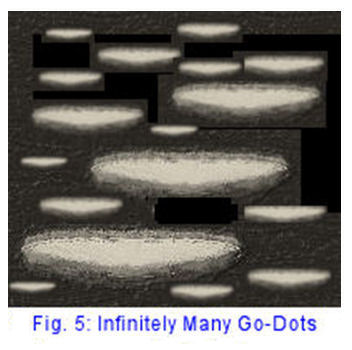|
Godots: Neither Energy nor Matter but a 'Third Thing'

If gravity is causing the accerating expansion, then gravity is our dark energy—no longer dark, no longer mysterious, no longer requiring the invention of wild and shaky new ways to prop up an old paradigm whose time has expired, and which must make way for new ideas.
As mentioned in previous pages, there is stuff out here. But what sort of stuff? In sticking to the rule of simplicity, I'm going to just name one kind of stuff, and say it is neither matter nor energy, but the most fundamental thing of all things.
As discussed at length in my side notes (previous page), the go-dot is neither a wave or a particle, neither energy nor matter, but a third thing. Since the only property we know for sure it has is gravity, I'll stick with the bare bones of necessity and call it a platelet of pure gravity. It is the fundamental and self-defined unit of pure gravitation.
|
NOTE: This 'old paradigm' is a reference taken from the now removed lead-in sections of my 2008 edition of this book. In the current edition, I skip over the history (and my own learning process at the time) and go directly to the exogravitation theory that is, after all, the critical core of this endeavor. Worth noting: in my 2008 edition, I elaborate on how existing scientific models keep being patched as new, contradictory data arrive…until a point of no return arrives, where we have to ditch the old model and move to something radically new.
Of the examples I cite in the 2008 edition, the most jarring is that of Ptolemy's 2nd Century concept that the universe consists of planetae (wandering objects) that move along circular paths in the heavens (in a geocentric universe). When in early modern times it was discovered that Mars often moves in apparent retrograde fashion as observed relative to Jupiter, Ptolemaic theory was patched up as 'cycles and epicycles.' This added smaller, retrograde cycles to account for the apparent motion of planets, until the entire Ptolemaic myth had to be discarded in the age of Copernicus, Kepler, Newton, Tycho Brahe, and other observers on the way toward a more modern theory that included the development of mathematical calculus describing elliptical orbits in a heliocentric rather than geocentric universe.
Sistine Chapel. Other examples of paradigm shift cited in my earlier (2008, 2015) editions included the Catholic Church's response to the influx of Hellenic, Turkish, and Arabic scholarship versus the predominance of European Medieval Latin and Scholasticism. This is captured poignantly, evocatively, and perhaps desperately in the purpose and layout of the Sistine Chapel, named for Pope Sixtus IV (late 1400s, right at the cusp of the Early Modern age). The Sistine Chapel, whose complex parts travel from Creation at the entrance across all of time to the Last Judgment above the main altar, tries to reconcile new understandings of how the Christian message interlocks with its spiritual sources in Hebrew Scripture and polytheistic ('pagan') cosmology, the latter as personified in the ancient cult of Sibyls.
Einstein/Le Maître/Hubble/et al.. While the earliest paradigm shift(s) mentioned date to Classical Athens (where geocentric and heliocentric notions already sparred amid accusations of blasphemy against polytheistic deities like Zeus (Theos), and I discuss the Sistine Chapel in its very transitional historic age at the culmination of the Renaissance and beginning of Early Modern times, and I already discussed the collapse of Ptolemaic 'cycles and epicycle' theory, likewise the 1920s became a locus of jarring change. The last vestiges of Copernican heliocentric theory fell by the wayside, even as our concept of the universe broadened (vastly) so that the Milky Way galaxy was no longer seen as the entire universe. In fact, even in our galaxy, our solar system is not even close to the galactic center, but in fact resides in an obscure trailer park on the remote fringes of one galactic arm filled with stars (and, we now know) full of solar systems.
Another key take-away is that we have to be prepared to find ever larger structures, as exemplified by the discovery of 'walls of galaxies' and the like. At Palomar Observatory in San Diego County, California, as one enters the main building, one sees inscribed over the doorway a number with at least twenty zeroes after it, that describes however vaguely the unimaginably vast number of stars in the universe.
Exogravitation adds yet another, larger, unimaginably vast structural layer (which I call the Motherverse, but some will call it the Metaverse or the like). Our cosmos or universe (I tend to use the two terms interchangeably) is just one of infinitely many universes much like our own whose multi-billion year life span from birth (Big Bang, Standard Model) to death (attenuation beyond its internal gravitational or centripetal reach or Cosmopause) is just a blink of an eye in cosmic time.
|

This platelet needs a name (see notes below for added info). A handy metaphor comes to us from the Japanese game of Go, which has white and black stones that look like dots from a distance. Rather than appropriate any existing nomenclature (e.g., boson), we'll find it useful to call our 'thing' of pure gravity a go-dot, pronounced like go+dot, not like the character in the famous play about despair and meaninglessness.
This go-dot (I prefer 'godot') has to have at least three properties.
(1) it is sticky, in the sense that two of them will tend to clump together by gravitation.
(2) it is almost unimaginably tiny. That's why we can't see it. If it were big, it would come flopping along and hit us in the face. It's much more wholesome to think of it as a particle so infinitesimal, that a tiny quark would look as big as the solar system next to it.
(3) for lack of a better measure, we can assume there are infinitely many of them, which contributes to the sense that the motherverse is extremely granular and discrete (not lumpy and pulling us in a finite set of directions).
(4) since they are not all stuck together in one lump, they must move about, which suggests something akin to what molecular scientists call random Brownian motion.

|
Side Note: Go Dots (Not A Trivial Metaphor)
Where The Term Comes From. I originated this term, to the best of my memory, around 2003 as I authored the science fiction novel Meta4City in my DarkSF series of SF novels (see: Caffeine Books and look for the DarkSF section among my several dozen fiction novels. As these notes will show, it was not a trivial choice. Let's discuss terminology and concepts if you have time. And I can only scratch the surface here.
The Dark Chocolate of Speculative Fiction. The term DarkSF does not refer to horror, slasher, gory, or other juvenile fare, but rather to the rich, atmospheric artistry of the 1982 film masterpiece Blade Runner (dir. Ridley Scott), my personal all-time favorite movie. I have yet to write an homage to that film, although my SF novel Nebula Express is an homage to Ridley Scott's wonderful 1979 SF film Alien.
Before firming up the exograv concept, I imagined there being some nano-sub-atomic 'things' that are not particles nor energy in any standard detectable form, but platelets of pure gravitation that otherwise lack mass or energy. This quality is a critical concept in understanding my exogravitation theory when it comes to that other great mystery of our age, 'dark matter.' My exogravitation theory is able to address both mysteries (dark energy and dark matter) in a plausible, comprehensive manner. In Meta4City, I borrowed go dots or stones (from the Japanese game Go) as a metaphor for infinitesimally small platelets of pure gravitation. Again: neither mass nor energy, so not a particle in any standard sense, so we are in an unprecedented realm.
In Meta4City, I was continuing to explore my long-held interest in cosmology, although this was before the fateful day when my exogravitation (exograv) theory came to mind. In Meta4City, which was in some ways an homage to the classic dystopian movie Brazil, in terms of atmosphere. It is even more inspired by a computer/internet age trope seen in films like TRON (1982, dir. Steven Lisberger) and novels like Simulacron-3 (1964 by Daniel F. Galouye). The latter (Galouye's) novel became the archetype that helped spawn films like Inception, Dark City, and more. More info here.
In Meta4City, explored the notion of what would happen if we could severely compress the space among sub-atomic particles. I was intrigued by the idea that our real universe is composed of atoms and molecules, whose sub-atomic particles are astoundingly tiny in contrast with the empty space among them.] My SFnal notion was that we would then have what is sometimes called 'pocket universes' in the SF field. Again, that is a fictional trope I explored for story purposes.
I explored related notions in my 1990 DarkSF novel This Shoal of Space (earlier titled Heartbreaker and later also published as Woman in the Sea and Starlight Deep Within a Gothic Sea that was well-loved by readers around the world as one of history's first HTML novels (online) in the late 1990s. See the Reviews and History section of Caffeine Books as well as the Clocktower Books Museum site. Topics include my choice of the pseudonym John Argo in that 1990s age of dawning cyberspace wonder, which reminded me of the archetypal Bronze Age ship of wonder Argo on which Jason and the Argonauts (literally, 'Argo-Sailors') set out on fabulous adventures in the cyberspace of imagination of that age, sailing the Aegean and Pontic and western Mediterranean Seas in the first glimmering of gray dawn foreshadowing our modern world.
Jorge Luis Borges et al. A discussion of hyper-reality and the like cannot be complete without at least one nod to past masters. There are quite a few throughout the history of literature. One of my favorites is the Argentine author Jorge Luis Borges (1899-1986). Borges, among the surrealist authors, wrote many works that explore the parallel worlds of imagination, but for present purposes I'll mention one short story as a prime example: The Circular Ruins.
Summing Up: My use of the term 'go-dot' comes from a literary place but goes to a rigorous scientific concept. Again, I am conjecturing 'platelets' (not particles or energy waves) of pure gravitation so infinitesimally small that they make sub-atomic particles gigantic as planets by comparison. This is the Dark Matter that comes with the process I have outlined for the birth, life, and death of universes, in which the Standard Model is a huge but momentary way-stop.
|



NOW AVAILABLE: The book (article) by John T. Cullen is now available for purchase at Amazon.com and other sites or stores. Visit:
|
E-Book
|
P-Book
|
Browse or Buy at Amazon
The book linked at left is an e-book edition to browse; or buy & download from Amazon for your Kindle reader.
The middle link is for the corresponding print edition. This short book is a standard 6x9" trim size. More info at Amazon.com.
Most print editions are also available at Barnes & Noble online; or call/visit your local bookstore to order.
|
TOP
|